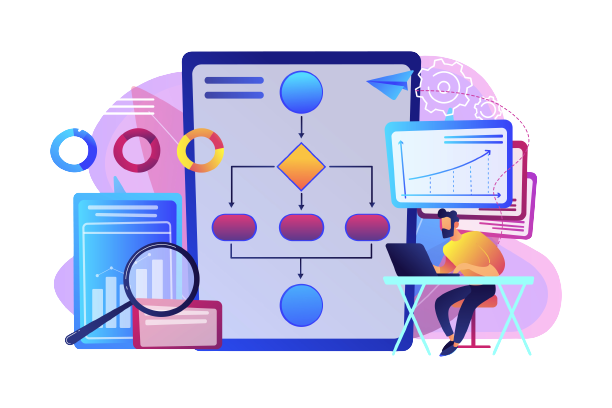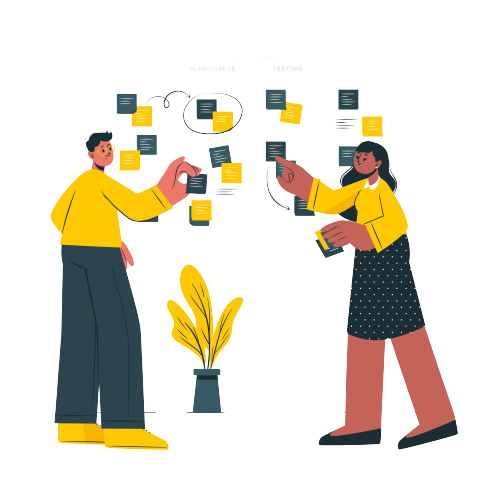
Smart Steps Forward: Navigating Business Growth through CRM Workflow Automationere the ability to streamline processes, enhance efficiency, and deliver exceptional customer experiences is paramount. This is where CRM workflow automation steps in as a revolutionary.
CRM workflow automation refers to the strategic utilization of technology to automate and optimize a series of tasks, activities, and processes within a CRM system. These tasks can range from simple, repetitive actions to complex, multi-step workflows. The primary objective of Workflow Automation in CRM is to reduce manual intervention, minimize errors, enhance operational efficiency, and elevate the overall customer experience.
As businesses strive to remain competitive and agile, the importance of CRM workflow automation cannot be overstated. Consider the following statistics that highlight its significance:
- Operational Efficiency: According to a study by McKinsey, businesses can automate approximately 30% of their tasks, leading to a significant boost in operational efficiency and employee productivity.
- Consistency: A survey by PricewaterhouseCoopers (PwC) found that 80% of consumers consider consistency in service delivery as a crucial factor in building brand trust. CRM workflow automation ensures consistent processes and interactions.
- Enhanced Customer Experiences: In a study by Salesforce, 72% of customers stated that they expect companies to understand their needs and expectations. CRM automation enables businesses to personalize interactions, leading to higher customer satisfaction.
- Data-Driven Insights: According to a report by Aberdeen Group, companies that utilize data-driven insights from CRM systems are more likely to achieve their revenue goals. Automation generates real-time data that empowers informed decision-making.
- Scalability: Businesses that use automation are twice as likely to see higher growth rates compared to those that don’t. Automation accommodates growth seamlessly, ensuring efficiency as customer interactions increase.
- Strategic Allocation of Resources: A survey by Deloitte found that companies that use automation effectively allocate resources 62% more efficiently than their competitors. By automating routine tasks, employees can focus on strategic initiatives.
At the core of CRM workflow automation is the concept of streamlining processes for optimal efficiency. Businesses can automate a wide range of tasks, including lead nurturing, customer onboarding, order processing, follow-up communications, and more. This streamlining not only saves time but also reduces the chances of errors that can arise from manual data entry.
In essence, the introduction of CRM workflow automation signifies a shift from labor-intensive, manual processes to a dynamic, technology-driven approach that optimizes operations and paves the way for sustainable growth.
As you continue reading this blog, you’ll get to know CRM marketing automation’s intricacies and strategies that businesses can adopt to leverage its full potential for achieving their growth aspirations. Let’s get started!
Understanding Workflow Automation in CRM

Workflow automation refers to the use of technology to automate and streamline a series of predefined tasks, actions, or processes within a CRM system. These processes can range from lead nurturing and customer onboarding to order processing and follow-up communications.
Similarly, workflows are visual representations of the automated processes within a CRM system. They illustrate the sequence of triggers, actions, and decision points that guide automation.
When we talk about automated processes, it means technology-driven execution. Once triggers are met, actions occur automatically, reducing the need for manual intervention. This results in efficiency gains, accuracy improvements, and the ability to handle higher volumes of tasks.
Advantages of Workflow Automation:

- Time Efficiency: Automated processes are executed instantly and consistently, saving valuable time compared to manual execution.
- Reduced Errors: Automation minimizes human errors, ensuring accuracy and preventing costly mistakes.
- Consistency: Automated processes follow predefined rules and conditions consistently, reducing variations in outcomes.
- Scalability: Automated workflows can handle larger volumes of tasks without requiring additional human resources.
- Focus on Value-Added Tasks: Employees can focus on higher-value tasks that require creativity, critical thinking, and strategic decision-making, as routine tasks are handled by automation.
- Improved Customer Experience: Automation enables timely responses, personalized interactions, and consistent follow-ups, enhancing the overall customer experience.
- Data Insights: Automated processes generate data that can be used for analysis and optimization, leading to informed decision-making.
Understanding the basics of workflow automation within CRM systems is fundamental to grasping the potential it holds for businesses.
Benefits of CRM Workflow Automation for Business Growth

One powerful tool that addresses these needs is CRM workflow automation. Let’s discuss the distinct advantages that CRM workflow automation offers to propel business growth.
1. Improved Operational Efficiency: Manual tasks can be time-consuming, prone to errors, and resource-intensive. CRM workflow automation steps in as a game-changer by automating repetitive processes, thereby boosting operational efficiency. Here’s how it works:
- Task Automation: Mundane tasks like data entry, lead assignment, and follow-up reminders are automated, freeing up valuable time for your team to focus on high-value activities.
- Reduced Errors: Automation minimizes human errors that can occur during manual data handling, ensuring data accuracy across processes.
- Time Savings: Manual tasks that once consumed hours can now be executed in moments, allowing your team to accomplish more within the same timeframe.
2. Enhanced Customer Experiences: Customers expect prompt responses and personalized interactions. CRM workflow automation facilitates exceptional customer experiences in the following ways:
- Quicker Response Times: Automated workflows ensure that customer inquiries and requests are promptly addressed, leading to heightened satisfaction and engagement.
- Personalization at Scale: Automation enables you to personalize interactions based on customer data, behavior, and preferences, fostering deeper connections.
- Consistent Engagement: Automated processes guarantee consistent engagement, ensuring that no customer is left waiting or overlooked.
3. Data-Driven Decision Making: Informed decisions are at the heart of successful business growth. CRM workflow automation empowers data-driven decision making by providing real-time insights:
- Data Accessibility: Automation integrates data from various sources into a centralized platform, offering a comprehensive view of customer interactions and behaviors.
- Real-Time Reporting: Automated reporting generates up-to-date analytics, enabling you to make informed decisions on sales strategies, marketing campaigns, and customer support efforts.
- Predictive Analytics: Some automation tools offer predictive analytics, helping you forecast trends and customer behaviors for strategic planning.
4. Scalability and Consistency: As businesses expand, maintaining consistency in processes becomes challenging. CRM workflow automation offers scalability and consistent operations:
- Effortless Scaling: Automated processes can handle increased workloads without compromising quality, allowing your business to grow seamlessly.
- Consistent Customer Experiences: Regardless of business growth, automation ensures that customer interactions adhere to defined processes and standards.
Incorporating CRM workflow automation into your business operations is a transformative step that directly contributes to your growth trajectory. It frees up valuable resources, optimizes processes, and empowers your team to focus on value-added tasks that drive innovation and customer satisfaction.
Identifying Automation Opportunities

In the pursuit of business optimization and growth, the role of automation cannot be understated. However, it’s essential to identify the right opportunities before you start using CRM software. We’ll now explore how to evaluate and prioritize processes that could benefit from automation, ensuring that your efforts lead to tangible improvements.
Evaluate Current Processes:

- Process Mapping: Begin by creating a comprehensive map of your current processes. This involves documenting each step, from the initiation of a task to its completion. This map serves as a visual representation of how work flows through your organization.
- Bottlenecks and Redundancies: Analyze your process map to identify bottlenecks, redundancies, and areas prone to errors. These are prime candidates for automation, as they often result in inefficiencies and decreased productivity.
- Repetitive Tasks: Pay special attention to tasks that are repetitive and routine in nature. These tasks are usually well-suited for automation since they involve minimal decision-making and can consume a significant amount of time.
- Manual Data Entry: Processes that involve manual data entry are susceptible to errors and can be time-consuming. Automation can significantly reduce errors and free up valuable employee time for more strategic tasks.
Prioritize Automation Targets:

- Impact on Business Goals: Consider the potential impact of automating a specific process on your overarching business goals. Will it lead to increased sales, improved customer satisfaction, or better resource allocation?
- Feasibility: Evaluate the feasibility of automating a process. Some processes may be complex or rely heavily on human judgment, making them challenging to automate effectively.
- Resource Allocation: Assess the resources required to implement automation. This includes financial investment, time, and the availability of technical expertise.
- Frequency and Volume: Processes that occur frequently or involve a high volume of transactions are ideal candidates for automation, as the time and effort saved can be substantial.
- ROI Potential: Consider the return on investment (ROI) of automating a process. Will the benefits in terms of time saved, reduced errors, and improved outcomes outweigh the costs of implementation?
- Customer Impact: Prioritize processes that directly impact customer experiences. Automation can lead to quicker response times and personalized interactions, enhancing customer satisfaction.
- Ease of Implementation: If you’re new to CRM automation, start with processes that are relatively straightforward to implement. As your team becomes more comfortable with automation tools, you can tackle more complex processes.
By evaluating current processes, uncovering bottlenecks, and prioritizing based on impact and feasibility, you’ll ensure that your automation efforts align with your business goals and yield substantial returns.
Strategies for Implementing CRM Workflow Automation

Effective implementation of CRM workflow automation is a cornerstone of driving efficiency and growth within a business. Let’s explore key strategies that businesses can follow to successfully integrate automation into their CRM systems and reap the benefits.
1. Mapping Out Workflows:
Mapping out workflows is a fundamental step in understanding the processes that can be automated within your CRM system. Here’s how to approach this process:
- Visual Representation: Begin by creating visual diagrams that outline each step of a process. This can be done using flowcharts, diagrams, or process mapping tools.
- Identifying Touchpoints: Identify key touchpoints where customer interactions occur, data is collected, or decisions are made. These touchpoints are potential areas for automation.
- Pinpointing Automation Points: Within the workflow, identify repetitive and rule-based tasks that can be automated to streamline processes.
2. Choosing the Right Tools:
Selecting the appropriate automation tools is crucial to ensuring a seamless integration with your CRM system. Consider the following when making your selection:
- Integration Compatibility: Ensure that the chosen automation tools are compatible with your CRM platform. Look for tools that offer native integrations or robust APIs.
- Feature Set: Evaluate the features offered by the automation tools. Consider whether they align with the automation points identified in your workflow mapping.
- Ease of Use: Opt for tools that are user-friendly and provide intuitive interfaces. The goal is to simplify the automation process, not complicate it.
- Scalability: Choose tools that can scale alongside your business growth. This is essential to accommodate increasing demands and evolving processes.
3. Customization:
Customization is the key to tailoring automation workflows to match your business’s unique needs. Here’s why customization matters and how to approach it:
- Alignment with Business Processes: Your CRM workflow automation should mirror your established business processes rather than forcing your processes to fit the automation.
- Defining Rules and Triggers: Determine the conditions under which automation should occur. For instance, an email could be triggered when a lead reaches a certain stage in the sales pipeline.
- Personalization: Leverage customization options to create personalized customer interactions. Automation doesn’t mean sacrificing the personal touch; it means enhancing it.
4. Test and Iterate:
Implementing CRM workflow automation isn’t a one-size-fits-all endeavor. It requires testing, refinement, and continuous improvement:
- Pilot Testing: Before implementing automation across the board, conduct pilot tests on selected processes. This allows you to identify any issues or optimizations needed.
- Gathering Feedback: Involve your team in the testing phase and gather their feedback. They may provide valuable insights on usability and effectiveness.
- Iterative Approach: Embrace an iterative approach to automation. Continuously monitor and adjust your workflows based on performance data and changing business needs.
By following these strategies, businesses can strategically implement CRM workflow automation to enhance efficiency, accuracy, and overall growth. The true value of CRM workflow automation lies in its ability to empower your team, optimize processes, and provide a foundation for sustainable business growth.
Continuous Improvement and Adaptation: Enhancing CRM Workflow Automation for Optimal Results

The journey to success is not a one-time event but a continuous evolution. This principle is no different when it comes to CRM workflow automation. As businesses embrace the power of automation to streamline processes and drive growth, the importance of continuous improvement and adaptation becomes evident. It’s time to know why these elements are crucial and how CRM workflow automation can be harnessed for lasting success.
Emphasizing Continuous Improvement
Effective automation doesn’t end with the initial implementation—it’s an ongoing endeavor. Here’s why continuous improvement is vital in the context of CRM workflow automation:
- Optimizing Efficiency: Over time, patterns of inefficiency or bottlenecks might emerge. Continuous improvement enables you to identify and rectify these issues, ensuring that your automated workflows remain as efficient as possible.
- Staying Relevant: Business environments are dynamic, with evolving customer expectations and market trends. Continuous improvement allows you to keep your automated processes aligned with changing demands, ensuring they remain relevant and effective.
- Maximizing ROI: As automation becomes an integral part of your operations, optimizing its performance directly impacts your return on investment. Regular assessments and enhancements keep the value proposition strong.
- Adapting to New Technologies: Emerging technologies often present opportunities for enhanced automation. By continuously improving your workflows, you can integrate new tools and methods that push your operations to new heights.
Strategies for Continuous Improvement
- Regular Audits: Schedule regular audits of your automated workflows to identify any inefficiencies, redundancies, or areas for enhancement.
- Collect Feedback: Involve your team members who interact with the automated processes. Their insights can reveal pain points and potential improvements.
- Analyze Data: Leverage the data collected through your CRM and automation tools. Analyze trends to identify where adjustments are needed.
- Benchmarking: Compare your automated processes with industry best practices to identify areas where you can raise the bar.
Adapting to Changing Business Needs
CRM workflow automation provides the flexibility to evolve alongside your business. Here’s how:
- Changing Priorities: As your business objectives shift, your automated workflows should align with new priorities. Whether it’s focusing on a different customer segment or altering your sales strategy, automation can be adjusted to match.
- Scaling Operations: Business growth often requires scaling operations. Automated processes can be expanded to accommodate higher volumes without sacrificing efficiency.
- New Technologies: Technological advancements introduce innovative tools that can enhance your automation. By adapting, you can incorporate these tools to gain a competitive edge.
- Customization: Modern CRM systems allow for customization of workflows. This means that as your business evolves, so can your automated processes.
Strategies for Adaptation:
- Regular Evaluation: Set intervals for evaluating your automated workflows against your current business goals and needs.
- Flexibility in Configuration: Choose automation tools that offer flexibility in configuration. This enables you to make adjustments without overhauling your entire setup.
- Collaboration with IT: Work closely with your IT department or software provider to ensure that your CRM and automation tools can adapt seamlessly to new requirements.
- Training and Communication: When adapting automated processes, ensure that your team members are informed and trained on the changes. This promotes smooth transitions.
Embracing these principles within the realm of CRM workflow automation positions your business for optimal results.
Chart Your Course to Success!
As you consider the insights shared in this exploration, remember that the journey to business growth is unique for every organization. CRM workflow automation isn’t just a tool; it’s a transformative strategy that propels businesses forward. By integrating automation into your CRM processes, you’re embracing a future where efficiency, customer satisfaction, and informed decision-making converge to shape your success story.
Embrace the power of CRM workflow automation as your trusted companion on the path to success. As your business evolves, let automation be the driving force that ensures you stay ahead, innovate, and achieve your growth objectives. With the right tools, strategies, and a commitment to continuous improvement, you’re poised to reach new heights and navigate your journey to business growth with confidence.